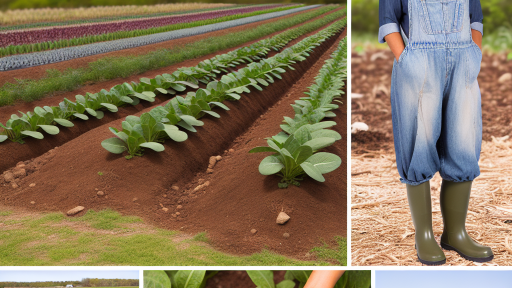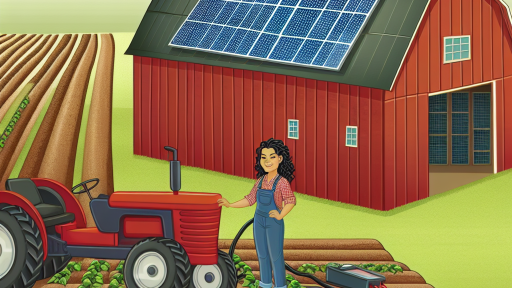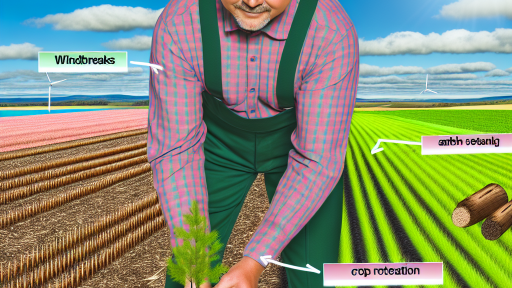Introduction to Climate-Smart Agriculture
Climate-smart agriculture aims to improve productivity sustainably.
It offers solutions to adapt to climate change impacts.
Additionally, it reduces greenhouse gas emissions from agricultural practices.
Defining Climate-Smart Agriculture
This approach integrates sustainable farming methods.
It focuses on resilience to climate-related challenges.
Farmers adopt practices that enhance soil health and biodiversity.
Benefits of Climate-Smart Practices
- Improved crop yields under changing climate conditions.
- Increased resilience against climate variability.
- Reduced emissions from agricultural activities.
Key Components of Climate-Smart Agriculture
The first component emphasizes sustainable productivity.
It encourages efficient use of resources like water and nutrients.
Secondly, it aims for adaptive capacity to climate impacts.
Farmers implement strategies to manage risks effectively.
Lastly, climate-smart agriculture seeks to mitigate climate change.
Examples of Climate-Smart Practices
- Crop rotation to enhance soil fertility.
- Conservation tillage to prevent soil erosion.
- Integrated pest management to reduce chemical inputs.
Challenges Facing Climate-Smart Agriculture
Many farmers struggle with initial investment costs.
Furthermore, access to modern technology can be limited.
Education and training on practices are also essential.
Lastly, policy support is critical for successful implementation.
Transform Your Agribusiness
Unlock your farm's potential with expert advice tailored to your needs. Get actionable steps that drive real results.
Get StartedUnderstanding Soil Health and Fertility Management
Importance of Soil Health
Soil health is critical for sustainable agriculture.
Healthy soil supports diverse ecosystems.
Moreover, it enhances crop resilience against pests.
Furthermore, it improves water retention and drainage.
Soil health contributes to higher yields.
Key Indicators of Soil Health
Several indicators can help assess soil health.
Soil structure is essential for root growth.
Soil organic matter indicates nutrient availability.
Additionally, soil pH affects nutrient uptake.
Soil biodiversity is another crucial factor.
Practices for Enhancing Soil Fertility
Improving soil fertility involves several practices.
Crop rotation helps maintain nutrient balance.
Cover cropping prevents soil erosion and enhances fertility.
Addition of organic matter improves soil structure.
Utilizing compost enriches soil with nutrients.
Importance of Soil Testing
Frequent soil testing is vital for effective management.
Testing helps determine nutrient levels and pH.
It provides insights into soil organic matter content.
Moreover, it identifies any contamination issues.
Timely testing ensures tailored fertilizer applications.
Utilizing Sustainable Fertilizers
Sustainable fertilizers reduce environmental impact.
Organic fertilizers enhance soil life and structure.
Incorporating green manure adds nutrients naturally.
Additionally, biofertilizers promote healthy microbial activity.
Showcase Your Farming Business
Publish your professional farming services profile on our blog for a one-time fee of $200 and reach a dedicated audience of farmers and agribusiness owners.
Publish Your ProfileUsing slow-release fertilizers minimizes nutrient loss.
Implementing Conservation Practices
Conservation practices protect and enhance soil health.
No-till farming minimizes soil disturbance.
Terracing prevents soil erosion on sloped fields.
Moreover, agroforestry integrates trees into farming landscapes.
These practices contribute to sustainable crop production.
Water Conservation Techniques in Crop Cultivation
Importance of Water Conservation
Water conservation plays a vital role in sustainable agriculture.
It directly impacts crop yield and quality.
Moreover, it helps in preserving local water resources.
Implementing Drip Irrigation
Drip irrigation efficiently delivers water to plant roots.
It minimizes evaporation and runoff compared to traditional methods.
Farmers can adjust the system according to crop needs.
Using Rainwater Harvesting
Collecting rainwater reduces dependence on external resources.
This technique captures and stores water for later use.
Farmers can utilize it during dry spells or low rainfall periods.
Soil Moisture Management
Maintaining optimal soil moisture is crucial for crop health.
Farmers can utilize soil moisture sensors for accurate measurements.
This technology helps in deciding irrigation schedules and amounts.
Crop Selection and Rotation
Choosing drought-resistant crop varieties reduces water needs.
Crop rotation enhances soil structure and moisture retention.
It also prevents plant diseases and boosts biodiversity.
Mulching Techniques
Applying mulch helps in retaining soil moisture.
It reduces weed competition and enhances soil temperature.
Organic mulches improve soil quality as they decompose.
Effective Fertilization Practices
Proper fertilization supports efficient water use in crops.
Farmers should focus on timing and type of fertilizer applied.
This helps prevent nutrient leaching and enhances crop uptake.
Monitoring and Technology Applications
Technology can greatly enhance water conservation efforts.
Farmers can utilize weather forecasting for better planning.
Data-driven irrigation systems optimize water usage effectively.
Uncover the Details: Carbon Sequestration’s Impact on Farm Profits
Choosing Climate-Resilient Crop Varieties
Understanding Climate Resilience
Climate resilience refers to a crop’s ability to withstand extreme weather conditions.
This includes droughts, floods, and temperature fluctuations.
Farmers can enhance their productivity by selecting adaptive crops.
Evaluating Local Conditions
First, assess local environmental conditions.
Consider soil type, rainfall patterns, and temperature ranges.
These factors strongly influence crop performance.
Local agricultural extension services can provide valuable information.
Researching Crop Varieties
Next, research various crop varieties available in your region.
Focus on those proven to perform well in local climates.
Showcase Your Farming Business
Publish your professional farming services profile on our blog for a one-time fee of $200 and reach a dedicated audience of farmers and agribusiness owners.
Publish Your ProfileVarieties developed through breeding programs often exhibit resilience traits.
Additionally, traditional or indigenous varieties may offer advantages.
Utilizing Seed Banks
Consider utilizing seed banks as a resource.
Seed banks preserve diverse crop genetics.
This genetic diversity helps in adapting to climate variations.
Organizations like the Global Crop Diversity Trust offer access to such seeds.
Participating in Community Programs
Join local agricultural cooperatives or community programs.
These groups often focus on climate-smart practices.
The collective experience can guide better crop selection.
Moreover, participating in field trials can provide hands-on insights.
Staying Informed on Innovations
Stay updated on agricultural innovations and climate research.
Attend workshops and seminars related to climate-smart practices.
Technology continues to evolve in crop breeding and selection.
Being informed enhances your decision-making process.
Explore Further: Implementing Biochar in Agriculture for Carbon Storage
Integrating Agroforestry into Crop Production Systems
Understanding Agroforestry
Agroforestry combines agriculture and forestry practices.
This method enhances biodiversity and ecosystem services.
Farmers plant trees alongside crops to create a sustainable system.
As a result, agroforestry improves soil fertility and moisture retention.
Benefits of Agroforestry
One significant benefit is increased crop yields.
Trees provide shade, thereby reducing stress on crops.
This approach also enhances pest control through natural predation.
Additionally, trees act as windbreaks, protecting sensitive crops.
Importantly, agroforestry helps sequester carbon, combating climate change.
Designing Agroforestry Systems
Effective agroforestry begins with careful planning and design.
Farmers should consider local climate conditions and soil types.
Moreover, selecting appropriate tree species is crucial for success.
For instance, leguminous trees can enhance soil nitrogen levels.
Implementing Agroforestry Practices
Farmers can implement several practices to integrate agroforestry.
Intercropping is one effective method, planting crops and trees together.
Another practice involves alley cropping, where trees line wide rows of crops.
Farmers may also use silvopasture, combining trees, crops, and livestock.
Challenges in Agroforestry
Despite its benefits, agroforestry presents certain challenges.
Initially, establishing a diverse system may require significant investment.
Farmers often need training to manage agroforestry systems effectively.
Additionally, market access for agroforestry products can be limited.
Case Studies of Successful Agroforestry
Various farms globally have successfully integrated agroforestry.
The Green Acres Farm in Georgia demonstrates profitability through integration.
Similarly, the EcoFarm Project in Kenya showcases biodiversity and sustainability.
Both practices highlight the numerous advantages of adopting agroforestry.
Showcase Your Farming Business
Publish your professional farming services profile on our blog for a one-time fee of $200 and reach a dedicated audience of farmers and agribusiness owners.
Publish Your ProfileFuture Directions for Agroforestry
Looking ahead, agroforestry will play a vital role in climate-smart agriculture.
Innovations in technology can facilitate agroforestry implementation.
Collaboration among farmers, researchers, and governments is essential.
Furthermore, public awareness can promote the adoption of these practices.
You Might Also Like: Adapting Farming Practices to Changing Water Patterns

Utilizing Precision Agriculture Technologies for Efficiency
Introduction to Precision Agriculture
Precision agriculture employs technology to enhance farming efficiency.
This approach optimizes field variability in crops.
Farmers can make informed decisions based on data analysis.
Key Technologies in Precision Agriculture
- GPS technology guides planting and harvesting precision.
- Drones provide aerial imagery for crop monitoring.
- Soil sensors measure moisture and nutrient levels.
Benefits of Precision Agriculture
These technologies significantly reduce input costs.
Farmers can apply fertilizers and pesticides more accurately.
Moreover, this strategy minimizes environmental impact.
Consequently, crop yields become more sustainable and profitable.
Implementing Precision Agriculture Techniques
Farmers should start by assessing their needs and resources.
Next, they can invest in appropriate precision tools.
Training is essential to effectively use these technologies.
Collaboration with agronomists enhances implementation strategies.
Monitoring and Adjustment
Constant monitoring is crucial for success in this approach.
Farmers must analyze data regularly for optimal results.
Adjustments should be made based on real-time feedback.
This dynamic process leads to continuous improvement in practices.
Discover More: Top Farming Methods to Handle Climate Shifts
Implementing Crop Rotation and Diversity for Sustainability
Importance of Crop Rotation
Crop rotation enhances soil health and fertility.
It interrupts pest and disease cycles effectively.
Furthermore, crop rotation improves nutrient availability.
Methods of Crop Rotation
Farmers can implement several crop rotation strategies.
- Sequential cropping involves planting different crops in subsequent seasons.
- Cover cropping adds organic matter and prevents erosion.
- Intercropping allows for simultaneous cropping of different plants.
Benefits of Agricultural Diversity
Diverse cropping systems strengthen ecosystem resilience.
They support a variety of beneficial organisms and pollinators.
Moreover, they minimize the risk of total crop failure.
Implementing Biodiversity on the Farm
Farmers can integrate various plant species into their cultivation practices.
- Choose crops from different plant families for better pest management.
- Incorporate native plants to attract beneficial insects.
- Adopt agroforestry principles to enhance biodiversity.
Monitoring and Adapting Practices
Regular monitoring of soil health is essential.
Farmers should adjust their practices based on observed results.
Additionally, continuous education on sustainable practices is crucial.
The Role of Integrated Pest Management for Reducing Chemical Use
Understanding Integrated Pest Management
Integrated Pest Management (IPM) combines various management strategies.
Farmers use IPM to control pest populations effectively.
This approach promotes environmental sustainability and crop health.
By using IPM, farmers can reduce their reliance on chemical pesticides.
Benefits of Integrated Pest Management
IPM offers several key benefits for farmers and the environment.
First, it minimizes chemical inputs, protecting beneficial insects.
This practice supports the ecosystem in a significant way.
Secondly, IPM enhances pest resistance over pesticide applications.
Showcase Your Farming Business
Publish your professional farming services profile on our blog for a one-time fee of $200 and reach a dedicated audience of farmers and agribusiness owners.
Publish Your ProfileFarmers see decreased pest populations with reduced chemical use.
Moreover, it fosters a healthier soil environment, promoting crop growth.
Components of Integrated Pest Management
IPM consists of multiple components that work in harmony.
- Cultural practices enhance crop resilience and deter pests.
- Mechanical controls, such as traps, effectively manage pest numbers.
- Biological controls utilize natural predators to manage pests.
- Regular monitoring helps assess pest populations and control methods.
Farmers who adopt these practices enjoy greater overall success.
Implementing Integrated Pest Management
To implement IPM, farmers should start with education and planning.
Gathering data about pest life cycles is essential for effective strategies.
Additionally, farmers can collaborate with local extension services.
These resources provide valuable insights into pest management.
Success Stories and Case Studies
Many farmers have successfully reduced chemical usage through IPM.
For instance, Elena Torres, an organic farmer in Idaho, saw remarkable results.
By employing a combination of biological and mechanical controls, her pest problems diminished significantly.
Furthermore, her crop yields improved while reducing costs.
Future Directions in Integrated Pest Management
As agriculture evolves, IPM remains a key focus for sustainability.
Continuous research and innovation in pest management will enhance strategies.
Overall, IPM contributes to resilient farming systems worldwide.
Additional Resources
Climate Impacts in the Great Plains | Climate Change Impacts | US …
Climate-Smart Agriculture and Forestry Resources | Farmers.gov




